
Nyhavn is a 17th-century waterfront, canal and entertainment district in Copenhagen, Denmark. Stretching from Kongens Nytorv to the Inner Harbour just south of the Royal Playhouse, it is lined by brightly coloured 17th and early 18th century townhouses and bars, cafes and restaurants. The canal harbours many historical wooden ships.
Kai Holm was a Danish film actor. He appeared in 41 films between 1927 and 1979. He was born in Lemvig, Denmark and died in Denmark.
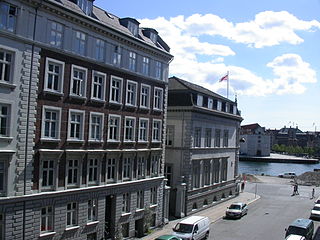
Gammelholm is a predominantly residential neighbourhood in the city centre of Copenhagen, Denmark. It is bounded by the Nyhavn canal, Kongens Nytorv, Holmens Kanal, Niels Juels Gade and the waterfront along Havnegade. For centuries, the area was the site of the Royal Naval Shipyard, known as Bremerholm, but after the naval activities relocated to Nyholm, it came under residential redevelopment in the 1860s and 1870s. The new neighbourhood was planned by Ferdinand Meldahl and has also been referred to as "Meldahl's Nine Streets". Apart from the buildings which face Kongens Nytorv, which include the Royal Danish Theatre and Charlottenborg Palace, the area is characterized by homogeneous Historicist architecture consisting of perimeter blocks with richly decorated house fronts.
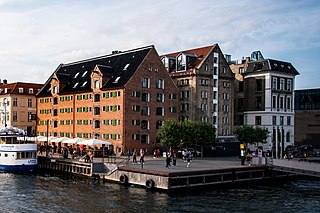
71 Nyhavn is a high-end hotel based in two converted warehouses on the corner of the Nyhavn Canal and the main harbourfront of Copenhagen, Denmark. It has 150 rooms and is after an upgrade completed in 2018 Apr-Hansen Hotel Group's most expensive hotel.

Larsens Plads is a waterfront in Copenhagen, Denmark, which runs along the Zealand side of the Inner Harbour from the Nyhavn canal in the south to the Nordre Toldbod area just south of Langelinie to the north. The name refers to a shipyard which used to occupy the grounds but is now more associated with emigration to America after it became a major hub for trans-Atlantic traffic later in the century. Today, the area is dominated by Amalienborg Palace with the Amalie Garden and a number of late 18th-century warehouses which have been converted to other uses. The buildings facing the waterfront have their address on the parallel street Toldbodgade.

Lightvessel No. XVII Gedser Rev is a decommissioned lightvessel built in 1895, now serving as a museum ship in Helsingør, Denmark, having formerly been stationed in the Nyhavn Canal in Copenhagen. It is owned by the National Museum and takes its name after Gedser Rev south of Falster where it was stationed most of its working life.

Sømandshjemmet Bethel, now known as Hotel Bethel, is a sailor's hostel overlooking the Nyhavn canal in central Copenhagen, Denmark. Today it is mainly used as a residential hotel. The site also comprises a sailor's church.
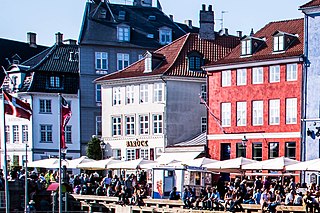
Nyhavn 1 is an 18th-century property at the acute corner of Nyhavn with Store Strandstræde in central Copenhagen, Denmark. It was listed in the Danish registry of protected buildings and places in 1987. Notable former residents include actor and singer Peter Schram (1819–1895).

Nyhavn 51 is an 18th-century canal house overlooking the Nyhavn canal in central Copenhagen, Denmark.Above the door is a painted stone relief depicting a lamb. The property was formerly known as Lammet and the sign was used for identification in a time when house numbers had still not been introduced. The letters are the initials of the builder Henrich Lambertsen Engel and his wife Karen Nielsdatter Holm. The building was listed in the Danish registry of protected buildings and places in 1918. It was subject to Schalburgtage during World War II but restored. Notable former residents include the portrait painter Hans Jørgen Hammer, the marine artist Carl Frederik Sørensen and Swedish actress Eva Eklund.

Nyhavn 20, also known as the Boel House, is a listed property overlooking the Nyhavn canal in central Copenhagen, Denmark. A plaque on the facade commemorates that Hans Christian Andersen lived in the building when he had his first fairy tale published.

Nyhavn 49 is a listed apartment building situated at the corner overlooking the Nyhavn Canal in central Copenhagen, Denmark. It originates in a two-storey townhouse from 1746 which belonged to the businessman and bank manager Rasmus Kirketerp from at least the 1790s and remained in the hands of the family until at least the early 1850s. This building was later heightened twice, first in the 1850s and then in 1887. The present building contains an ice cream parlour with homemade waffles in the basement and two residential apartments on each of the upper floors. It was listed in the Danish registry of protected buildings and places in 1945. Other notable former residents include the painter Otto Bache.
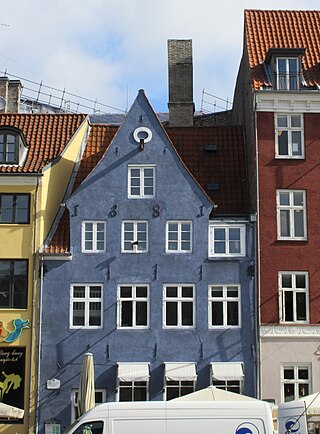
Nyhavn 9 is a historic townhouse overlooking the Nyhavn Canal in central Copenhagen, Denmark. It dates back to the 17th century and is one of few buildings along the canal that was not heightened in the 19th century. The building was listed on the Danish Registry of Protected Buildings and Places in 1918. It houses a restaurant on the ground floor.

Nyhavn 35 is a historic townhouse overlooking the Nyhavn Canal in central Copenhagen, Denmark. The building was listed in the Danish registry of protected buildings and places in 1945. Notable former residents include the businessman Jørgen Thomsen Bech and the composer Andreas Peter Berggreen.

Nyhavn 63 is a historic townhouse overlooking the Nyhavn Canal in central Copenhagen, Denmark. The building was listed on the Danish Registry of Protected Buildings and Places in 1918. A warehouse in the courtyard has been converted into a hostel.

Nyhavn 41 is a listed property overlooking the Nyhavn canal in central Copenhagen, Denmark. For most of the 19th century, the property was owned by a family of sailmakers. The manufacturing of flags and compasses was also part of their trade. The building was listed in the Danish registry of protected buildings and places in 1918.
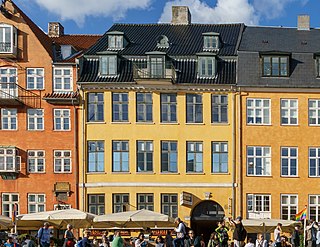
Nyhavn 43 is a historic townhouse overlooking the Nyhavn Canal in central Copenhagen, Denmark. The building was listed on the Danish registry of protected buildings and places in 1945. It was refurbished in 1987.

Nyhavn 55 is a just three-bays-wide, 18th-century canal house overlooking the Nyhavn Canal in central Copenhagen, Denmark. The building was listed in the Danish registry of protected buildings and places in 1918. The heritage listing comprises a half-timbered perpendicular side wing on its rear.

Nyhavn 47 is an 18th-century property situated at the corner of Nyhavn and Toldbodgade in central Copenhagen, Denmark. It owes its current appearance to a renovation undertaken by Julius Andreas Blom in 1842–45. It was listed in the Danish registry of protected buildings and places in 1932. Notable former residents include the merchant and shipowner Peter Christian Knudtzon.

Nyhavn 45 is an 18th-century property overlooking the Nyhavn Canal in central Copenhagen, Denmark. It was listed in the Danish registry of protected buildings and places in 1945.

Nyhavn 61 is an 18th-century residential building overlooking the Nyhavn canal in central Copenhagen, Denmark. The building was listed in the Danish registry of protected buildings and places in 1945. The scope of the heritage listing was expanded in 1984. Nyhavn 61 and Nyhavn 59 have now been merged into a single property and are physically integrated on the third floor. The two buildings share a central courtyard.




















